

Crust (geology) Earth's crust and mantle The internal structure of Earth The temperature of the crust increases with depth, reaching values typically in the range from about 200 °C (392 °F) to 400 °C (752 °F) at the boundary with the underlying mantle.
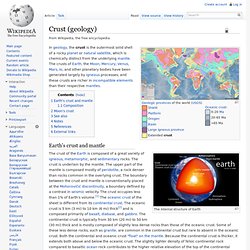
The crust and underlying relatively rigid uppermost mantle make up the lithosphere. Because of convection in the underlying plastic (although non-molten) upper mantle and asthenosphere, the lithosphere is broken into tectonic plates that move. The temperature increases by as much as 30 °C (about 50 °F) for every kilometer locally in the upper part of the crust, but the geothermal gradient is smaller in deeper crust.[3] Partly by analogy to what is known about the Moon, Earth is considered to have differentiated from an aggregate of planetesimals into its core, mantle and crust within about 100 million years of the formation of the planet, 4.6 billion years ago. Composition Moon's crust. Eoarchean. Isua greenstone belt. The Isua Greenstone Belt is an Archean greenstone belt in southwestern Greenland.
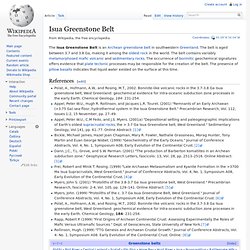
The belt is aged between 3.7 and 3.8 Ga, making it among the oldest rock in the world. The belt contains variably metamorphosed mafic volcanic and sedimentary rocks. The occurrence of boninitic geochemical signatures offers evidence that plate tectonic processes may be responsible for the creation of the belt.
The presence of pillow basalts indicates that liquid water existed on the surface at this time. Polat, A., Hofmann, A.W., and Rosing, M.T., 2002. Coordinates: Nuvvuagittuq greenstone belt. An outcrop of metamorphosed volcano-sedimentary rocks at Porpoise Cove.
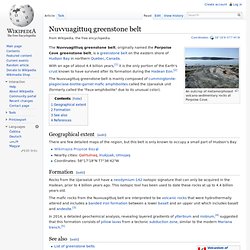
The Nuvvuagittuq greenstone belt, originally named the Porpoise Cove greenstone belt, is a greenstone belt on the eastern shore of Hudson Bay in northern Quebec, Canada. The Nuvvuagittuq greenstone belt is mainly composed of cummingtonite-plagioclase-biotite-garnet mafic amphibolites called the Ujaraaluk unit (formerly called the "Faux-amphibolite" due to its unusual color).
Geographical extent[edit] There are few detailed maps of the region, but this belt is only known to occupy a small part of Hudson's Bay Wikimapia Propose Bay Formation[edit] Rocks from the Ujaraaluk unit have a neodymium-142 isotopic signature that can only be acquired in the Hadean, prior to 4 billion years ago. The mafic rocks from the Nuvvuagittuq belt are interpreted to be volcanic rocks that were hydrothermally altered and includes a banded iron formation between a lower basalt and an upper unit which includes basalt and andesite.[3] Coordinates:
Acasta Gneiss. Fragment exhibited at the Natural History Museum in Vienna Found in 1989, it was named for the nearby Acasta River east of Great Bear Lake.[2][3] The Acasta outcrop is found in a remote area of the Tlicho people land settlement.
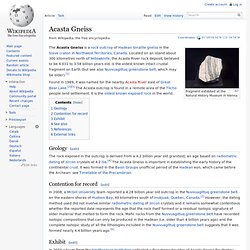
It is the oldest known exposed rock in the world. Geology[edit] Contention for record[edit] In 2008, a McGill University team reported a 4.28 billion year old outcrop in the Nuvvuagittuq greenstone belt on the eastern shores of Hudson Bay, 40 kilometres south of Inukjuak, Quebec, Canada.[2] However, the dating method used did not involve similar radiometric dating of zircon crystals and it remains somewhat contentious whether the reported date represents the age that the rock itself formed or a residual isotopic signature of older material that melted to form the rock.
Abiogenesis. Scientific hypotheses about the origins of life can be divided into a number of categories.
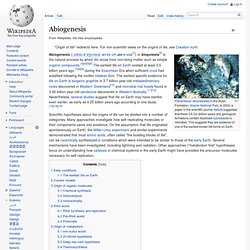
Many approaches investigate how self-replicating molecules or their components came into existence. On the assumption that life originated spontaneously on Earth, the Miller–Urey experiment and similar experiments demonstrated that most amino acids, often called "the building blocks of life", can be racemically synthesized in conditions which were intended to be similar to those of the early Earth. Several mechanisms have been investigated, including lightning and radiation. Other approaches ("metabolism first" hypotheses) focus on understanding how catalysis in chemical systems in the early Earth might have provided the precursor molecules necessary for self-replication.
Early conditions[edit] The Hadean Earth is thought to have had a secondary atmosphere, formed through degassing of the rocks that accumulated from planetesimal impactors. Vaalbara. Vaalbara is the Earth's theorized first supercontinent.[1] It was a complete supercontinent by 3,100 million years ago.
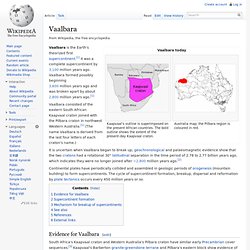
Vaalbara formed possibly beginning 3,600 million years ago and was broken apart by about 2,800 million years ago.[1] Vaalbara consisted of the eastern South African Kaapvaal craton joined with the Pilbara craton in northwest Western Australia.[1] (The name Vaalbara is derived from the last four letters of each craton's name.) It is uncertain when Vaalbara began to break up; geochronological and palaeomagnetic evidence show that the two cratons had a rotational 30° latitudinal separation in the time period of 2.78 to 2.77 billion years ago, which indicates they were no longer joined after ~2,800 million years ago.[2] Continental plates have periodically collided and assembled in geologic periods of orogenesis (mountain building) to form supercontinents.
Evidence for Vaalbara[edit] Supercontinent formation[edit] Mechanism for breakup of supercontinents[edit] See also[edit]